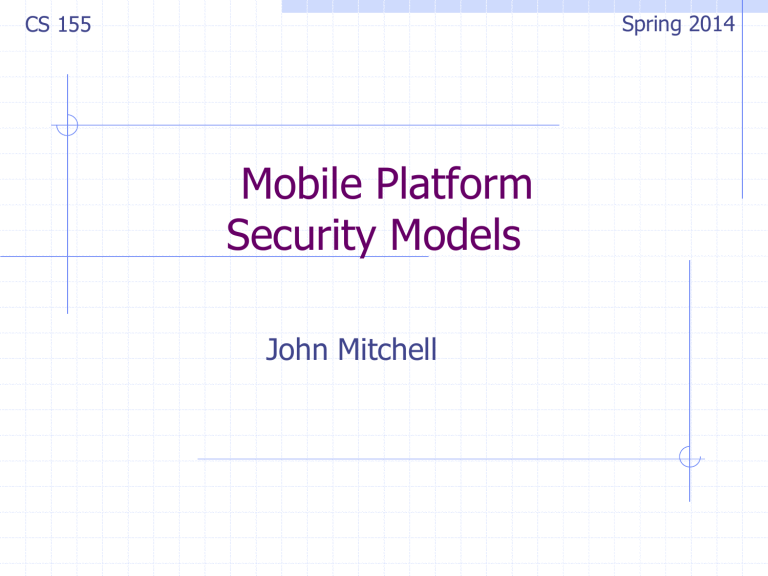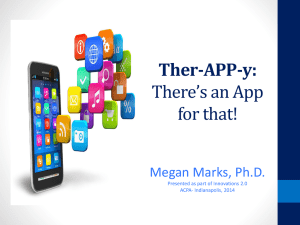ppt - Applied Crypto Group at Stanford University

CS 155
Mobile Platform
Security Models
John Mitchell
Spring 2014
2
Outline
Introduction: platforms and attacks
Apple iOS security model
Android security model
Windows 7, 8 Mobile security model
3
Mobile phone market share
4
5
Many mobile apps
6
Mobile Operating Systems
Mobile OS Vulnerabilities Mobile OS Exploits
8
Two attack vectors
Web browser
Installed apps
Both increasing in prevalence and sophistication source: https://www.mylookout.com/mobile-threat-report
9
Mobile malware attacks
Unique to phones:
Premium SMS messages
Identify location
Record phone calls
Log SMS
Similar to desktop/PCs:
Connects to botmasters
Steal data
Phishing
Malvertising
10
Mobile malware examples
DroidDream (Android)
Over 58 apps uploaded to Google app market
Conducts data theft; send credentials to attackers
Ikee (iOS)
Worm capabilities (targeted default ssh pwd)
Worked only on jailbroken phones with ssh installed
(could have been worse)
Zitmo (Symbian,BlackBerry,Windows,Android)
Propagates via SMS; claims to install a “security certificate”
Captures info from SMS; aimed at defeating 2-factor auth
Works with Zeus botnet; timed with user PC infection
11
Comparison between platforms
Operating system
(recall security features from lecture 5)
Unix
Windows
Approval process for applications
Market: Vendor controlled/Open
App signing: Vendor-issued/self-signed
User approval of permission
Programming language for applications
Managed execution: Java, .Net
Native execution: Objective C
12
Outline
Introduction: platforms and attacks
Apple iOS security model
Android security model
Windows 7 Mobile security model
Apple iOS
13
From: iOS App Programming Guide
iOS Platform
14
Kernel: based on Mach kernel like Mac OS X
Core OS and Core Services: APIs for files, network, … includes SQLite, POSIX threads, UNIX sockets
Media layer: supports 2D and 3D drawing, audio, video
Cocoa Touch: Foundation framework, OO support for collections, file management, network operations; UIKit
Implemented in C and Objective-C
iOS Application Development
15
Apps developed in Objective-C using Apple SDK
Event-handling model based on touch events
Foundation and UIKit frameworks provide the key services used by all iOS applications
Apple iOS Security
Device security
Prevent unauthorized use of the device
Data security
Protect data at rest; device may be lost or stolen
Network security
Networking protocols and encryption of data in transmission
App security
Secure platform foundation
16
Reference: http://images.apple.com/iphone/business/docs/iOS_Security.pdf
17
Device Security: passcodes
Strong passcodes
Passcode expiration
Passcode reuse history
Maximum failed attempts
Over-the-air passcode enforcement
Progressive passcode timeout
18
Data Security
Hardware encryption
Remote wipe
Local wipe
Encrypted Configuration Profiles
Encrypted iTunes backups
19
Network Security
Current accepted network security protocols
IPSec, L2TP, PPTP VPN
SSL VPN via App Store apps
SSL/TLS with X.509 certificates
WPA/WPA2 Enterprise with 802.1X
20
App Security
Runtime protection
System resources, kernel shielded from user apps
App “sandbox” prevents access to other app’s data
Inter-app communication only through iOS APIs
Code generation prevented
Mandatory code signing
All apps must be signed using an Apple-issued certificate
Application data protection
Apps can take advantage of built-in hardware encryption
iOS Sandbox
21
Limit app’s access to files, preferences, network, other resources
Each app has own sandbox directory
Limits consequences of attacks
Same privileges for each app
22
Comparison
Unix
Windows
Open market
Closed market
Vendor signed
Self-signed
User approval of permissions
Managed code
Native code x x iOS x x
Android Windows
23
Outline
Introduction: platforms and attacks
Apple iOS security model
Android security model
Windows 7, 8 Mobile security model
24
Android
Platform outline:
Linux kernel, browser, SQL-lite database
Software for secure network communication
Open SSL, Bouncy Castle crypto API and Java library
C language infrastructure
Java platform for running applications
Also: video stuff, Bluetooth, vibrate phone, etc.
25
26
Android market
Self-signed apps
Permissions granted on user installation
Open
Bad applications may show up on market
Shifts focus from remote exploit to privilege escalation
27
Security Features
Isolation
Multi-user Linux operating system
Each application normally runs as a different user
Communication between applications
May share same Linux user ID
Access files from each other
May share same Linux process and Dalvik VM
Communicate through application framework
“Intents,” based on Binder, discussed in a few slides
Battery life
Developers must conserve power
Applications store state so they can be stopped (to save power) and restarted – helps with DoS
28
Application development process
29
Application development concepts
Activity – one-user task
Example: scroll through your inbox
Email client comprises many activities
Service – Java daemon that runs in background
Example: application that streams an mp3 in background
Intents – asynchronous messaging system
Fire an intent to switch from one activity to another
Example: email app has inbox, compose activity, viewer activity
User click on inbox entry fires an intent to the viewer activity, which then allows user to view that email
Content provider
Store and share data using a relational database interface
Broadcast receiver
“mailboxes” for messages from other applications
30
Exploit prevention
100 libraries + 500 million lines new code
Open source -> public review, no obscurity
Goals
Prevent remote attacks, privilege escalation
Secure drivers, media codecs, new and custom features
Overflow prevention
ProPolice stack protection
First on the ARM architecture
Some heap overflow protections
Chunk consolidation in DL malloc (from OpenBSD)
ASLR
Avoided in initial release
Many pre-linked images for performance
Developed and contributed by Bojinov, Boneh
31
Application sandbox
Application sandbox
Each application runs with its UID in its own
Dalvik virtual machine
Provides CPU protection, memory protection
Authenticated communication protection using Unix domain sockets
Only ping, zygote (spawn another process) run as root
Applications announces permission requirement
Create a whitelist model – user grants access
But don’t want to ask user often – all questions asked as install time
Inter-component communication reference monitor checks permissions
32
Layers of security
Each application executes as its own user identity
Android middleware has reference monitor that mediates the establishment of inter-component communication (ICC)
Source: Penn State group Android security paper
33
Source: Penn State group, Android security tutorial
34
dlmalloc (Doug Lea)
Stores meta data in band
Heap consolidation attack
Heap overflow can overwrite pointers to previous and next unconsolidated chunks
Overwriting these pointers allows remote code execution
Change to improve security
Check integrity of forward and backward pointers
Simply check that back-forward-back = back, f-b-f=f
Increases the difficulty of heap overflow
35
Java Sandbox
Four complementary mechanisms
Class loader
Separate namespaces for separate class loaders
Associates protection domain with each class
Verifier and JVM run-time tests
NO unchecked casts or other type errors, NO array overflow
Preserves private, protected visibility levels
Security Manager
Called by library functions to decide if request is allowed
Uses protection domain associated with code, user policy
Comparison: iOS vs Android
App approval process
Android apps from open app store
iOS vendor-controlled store of vetted apps
Application permissions
Android permission based on install-time manifest
All iOS apps have same set of “sandbox” privileges
App programming language
Android apps written in Java; no buffer overflow…
iOS apps written in Objective-C
36
See also: http://palisade.plynt.com/issues/2011Oct/android-vs-ios/
37
Comparison
Unix
Windows
Open market
Closed market
Vendor signed
Self-signed
User approval of permissions
Managed code
Native code x x iOS x x x x x
Android x x
Windows
38
Outline
Introduction: platforms and attacks
Apple iOS security model
Android security model
Windows Phone 7, 8 security model
39
Windows Phone 7, 8 security
Secure boot
All binaries are signed
Device encryption
Security model with isolation, capabilities
Central repository of rules
3-tuple {Principal, Right, Resource}
Chamber boundary is security boundary
Chambers defined using policy rules
4 chamber types, 3 fixed size, one can be expanded with capabilities (LPC)
Expressed in application manifest
Disclosed on Marketplace
Defines app’s security boundary on phone
Services and Application all in chambers
WP8 has a richer capabilities list
42
Windows Phone OS 7.0 security model
Principles of isolation and least privilege
Each chamber
Provides a security and isolation boundary
Is defined and implemented using a policy system
The security policy of a chamber
Specifies the OS capabilities that processes in that chamber can access
43
Isolation
Every application runs in own isolated chamber
All apps have basic permissions, incl a storage file
Cannot access memory or data of other applications, including the keyboard cache.
No communication channels between applications, except through the cloud
Non-MS applications distributed via marketplace stopped in background
When user switches apps, previous app is shut down
Reason: application cannot use critical resources or communicate with Internet–based services while the user is not using the application
44
Four chamber types
Three types have fixed permission sets
Fourth chamber type is capabilities-driven
Applications that are designated to run in the fourth chamber type have capability requirements that are honored at installation and at run-time
45
Overview of four chambers
Trusted Computing Base (TCB) chamber
unrestricted access to most resources
can modify policy and enforce the security model.
kernel and kernel-mode drivers run in the TCB
Minimizing the amount of software that runs in the
TCB is essential for minimizing the Windows
Phone 7, 8 attack surface
46
Overview of four chambers
Elevated Rights Chamber (ERC)
Can access all resources except security policy
Intended for services and user-mode drivers
Standard Rights Chamber (SRC)
Default for pre-installed applications that do not provide device-wide services
Outlook Mobile is an example that runs in the SRC
Least Privileged Chamber (LPC)
Default chamber for all non-Microsoft applications
LPCs configured using capabilities (see next slide)
47
Granting privileges to applications
Goal: Least Privilege
Application gets capabilities needed to perform all its use cases, but no more
Developers
Use the capability detection tool to create the capability list
The capability list is included in the application manifest
Each application discloses its capabilities to the user,
Listed on Windows Phone Marketplace.
Explicit prompt upon application purchase
Disclosure within the application, when the user is about to use the location capability for the first time.
49
Managed code
Application development model uses of managed code only
50
.NET Code Access Security
Default Security Policy is part of the .NET Framework
Default permission for code access to protected resources
Permissions can limit access to system resources.
Use EnvironmentPermission class for environment variables access permission.
The constructor defines the level of permission (read, write,…)
Deny and Revert
The Deny method of the permission class denies access to the associated resource
The RevertDeny method will cause the effects of any previous Deny to be cancelled
51
Example: code requires permission
class NativeMethods
{
// This is a call to unmanaged code. Executing this method
// requires the UnmanagedCode security permission. Without
// this permission, an attempt to call this method will throw a
// SecurityException:
[DllImport("msvcrt.dll")] public static extern int puts(string str);
[DllImport("msvcrt.dll")] internal static extern int _flushall();
}
52
Example: Code denies permission not needed
[SecurityPermission(SecurityAction.Deny, Flags =
SecurityPermissionFlag.UnmanagedCode)] private static void MethodToDoSomething()
{ try
{
} catch (SecurityException)
{
Console.WriteLine(“ … ");
SomeOtherClass.method();
…
}
}
53
.NET Stackwalk
Demand must be satisfied by all callers
Ensures all code in causal chain is authorized
Cannot exploit other code with more privilege
Code A calls
A has P?
B has P?
Code B calls
Code C
Demand P
54
Stackwalk: Assert
The Assert method can be used to limit the scope of the stack walk
Processing overhead decreased
May inadvertently result in weakened security
55
Comparison between platforms
Operating system
Unix
Windows
Approval process for applications
Market: Vendor controlled/Open
App signing: Vendor-issued/self-signed
User approval of permissions
Programming language for applications
Managed execution: Java, .Net
Native execution: Objective C
56
Comparison
Unix
Windows
Open market
Closed market
Vendor signed
Self-signed
User approval of permissions
Managed code
Native code x x iOS x x x x x
Android x x
Windows x x x
7-> 8 x
57
Conclusion
Introduction: platforms and attacks
Apple iOS security model
Android security model
Windows 7, 8 Mobile security model


